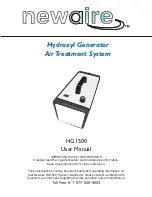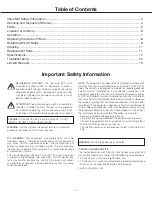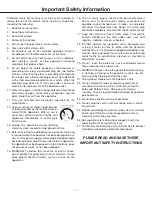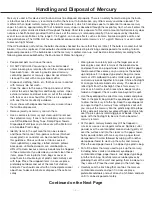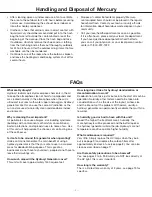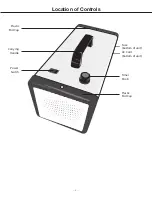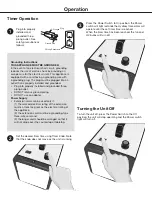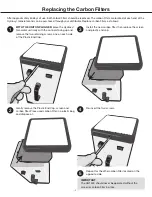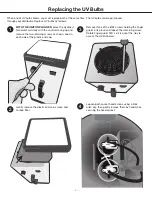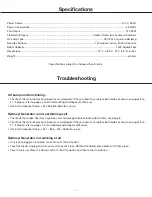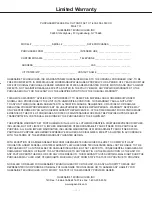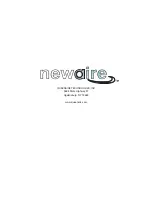
— 4 —
Handling and Disposal of Mercury
• People and pets must leave the room.
• DO NOT VACUUM. Vacuuming is not recommended
unless broken glass remains after all other cleanup steps
have been taken. Vacuuming could spread mercury-
containing powder or mercury vapor. Do not attempt to
clean up the spill with a mop or broom either.
• Dispose of clothing, fabric, etc. that has come in contact
with mercury; do not wash.
• Close the doors to the area of the spill and shut off the
central forced air heating/air-conditioning system. Open
exterior windows and direct room air out of the window
with fans or use an exhaust fan (if the area is equipped
with one) that vents directly outdoors.
• Cover shoes with disposable foot covers or wear shoes
that will be disposed of.
• Remove jewelry as mercury can ruin them.
• Use a commercial mercury spill clean-up kit to remove
the spilled mercury. If one is not available, you can also
use Stiff cardboard, Sticky Tape, Damp Paper Towels,
Disposable Wet Wipes and a Glass Jar with a Metal Lid
or a Sealable Plastic Bag.
• Identify items in the spill area that can be cleaned
and those that cannot. Non-porous surfaces (finished
wood, plastic or concrete) can be cleaned following
this guidance. Porous surfaces or fabric-covered
items (upholstery, carpeting, stuffed animals, pillows,
backpacks, unfinished wood, cork, cardboard) are
difficult to clean because mercury beads may be trapped
in these materials. If you decide you cannot clean these
items, place them in plastic trash bags or cover or
wrap them in a double layer of plastic and carefully seal
with tape. Place the wrapped items in a secure place,
preferably outdoors and out of the reach of children
and pets. You should consult with a trained professional
about how to decontaminate or dispose of these items
safely.
• Wear gloves to carefully pick up the larger pieces of
broken glass and what remains of the broken device
and place them on a paper towel. Gently fold the paper
towel around these pieces so you can pick the bundle
up and place it in a zipper-type plastic bag. Use index
cards or stiff cardboard to push smaller pieces of glass
and mercury beads together into a pile. Shine a flashlight
at an angle to locate beads of mercury. The beads will
reflect light from the flashlight. Check for mercury in
cracks or in hard-to-reach areas where beads may be
hidden or trapped. Check a wide area beyond the spill.
• Use the eyedropper to collect mercury beads and place
them in the plastic bag. Hold the eyedropper at an angle
to draw the mercury into the tip. Keep the eyedropper at
an angle to stop the mercury from rolling back out until
you can put the mercury into the plastic bag. Wrap tape
(sticky side out) around your gloved fingers and carefully
use it to pick up any remaining glass or beads. Check
again with the flashlight to be sure that no beads of
mercury remain.
• At this point, mercury beads may still be trapped in
cracks or crevices on irregular surfaces. Sprinkle sulfur
powder over the contaminated area and rub it gently all
over the surface and into the cracks with a paper towel.
Sulfur powder binds with mercury. Use a paper towel
dampened with water followed by wiping with another
damp paper towel to clean up the sulfur and mercury.
Place the used paper towels in a zipper-type plastic bag.
• Put all the items that were used to pick up the mercury,
including index cards or cardboard, eyedropper,
contaminated tape, paper towels, and zipper-type bags
into the trash bag. Carefully remove rubber gloves by
grabbing them at the wrist and pulling them inside out as
they come off. Place the used gloves in the trash bag.
• Carefully seal the trash bag that contains the mercury
contaminated waste and put it in a secure place,
preferable outdoors and out of reach of children and pets
until it can be disposed of safely.
Mercury is used in this device’s UV bulb and must be disposed of properly. There is no safety hazard as long as the bulb
is intact because the mercury is contained within the fixture. If a bulb breaks, very little mercury could be released. This
is different then liquid metallic mercury (like in a thermometer), which is hazardous due to its potential to release mercury
vapor. In humans, approximately 80% of inhaled mercury vapor is absorbed through the respiratory tract, where it enters the
circulatory system and is distributed throughout the body. Short term exposure to this small amount of spilled mercury does
not pose a health hazard, provided that the source of the mercury is removed promptly. Chronic exposure by inhalation,
even at low concentrations in the range 0.7–42 μg/m3, can cause effects such as tremors, impaired cognitive skills, and
sleep disturbance. The OHSA limit for occupational exposure of elemental mercury is 0.1 μg/m3. Mercury is used in most
fluorescent light fixtures.
If the UV bulb does not function, the bulbs should be checked to ensure that they are intact. If the bulb is cracked, but not
broken, it must be replaced. Cracked bulbs should be double sealed in plastic bags and disposed of according to local,
approved procedures. If the bulb breaks and the mercury is spilled, clean-up must be done immediately according to the
following procedure published by the Environment Protection Agency:
Continued on the Next Page

